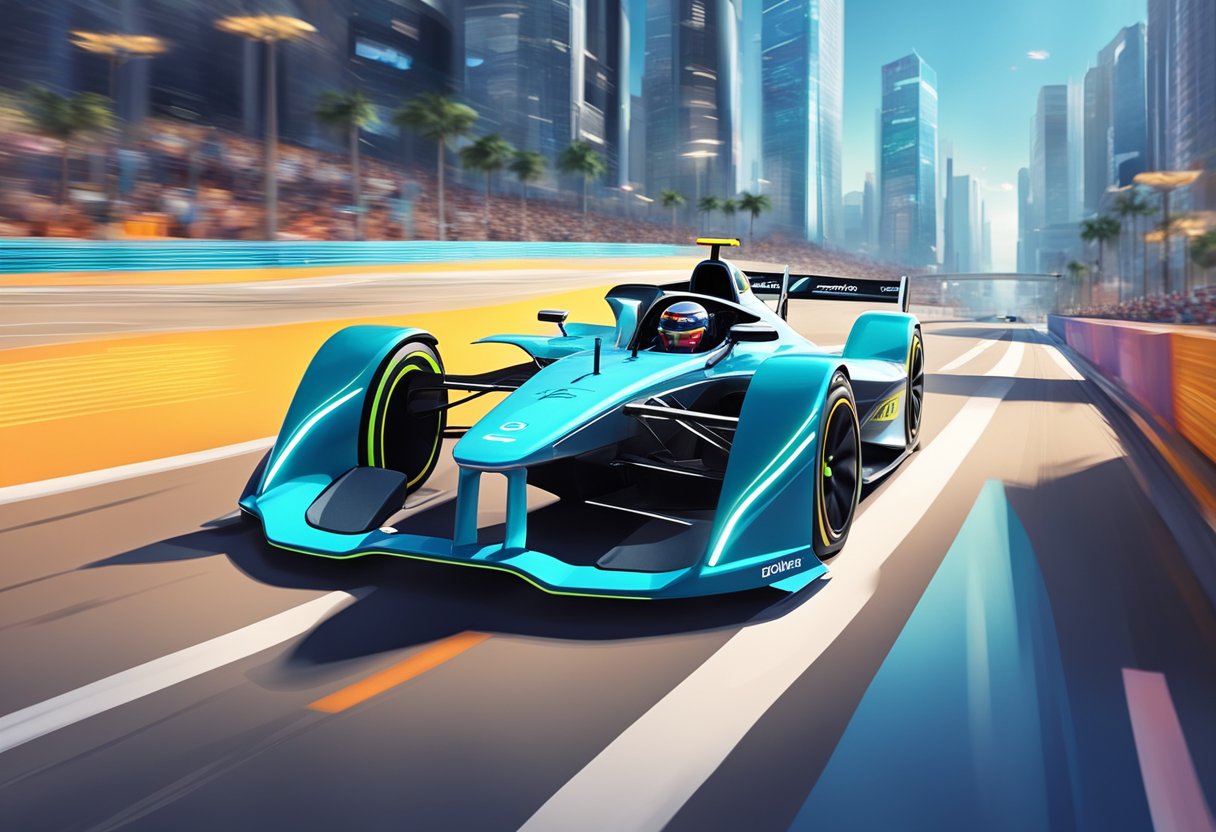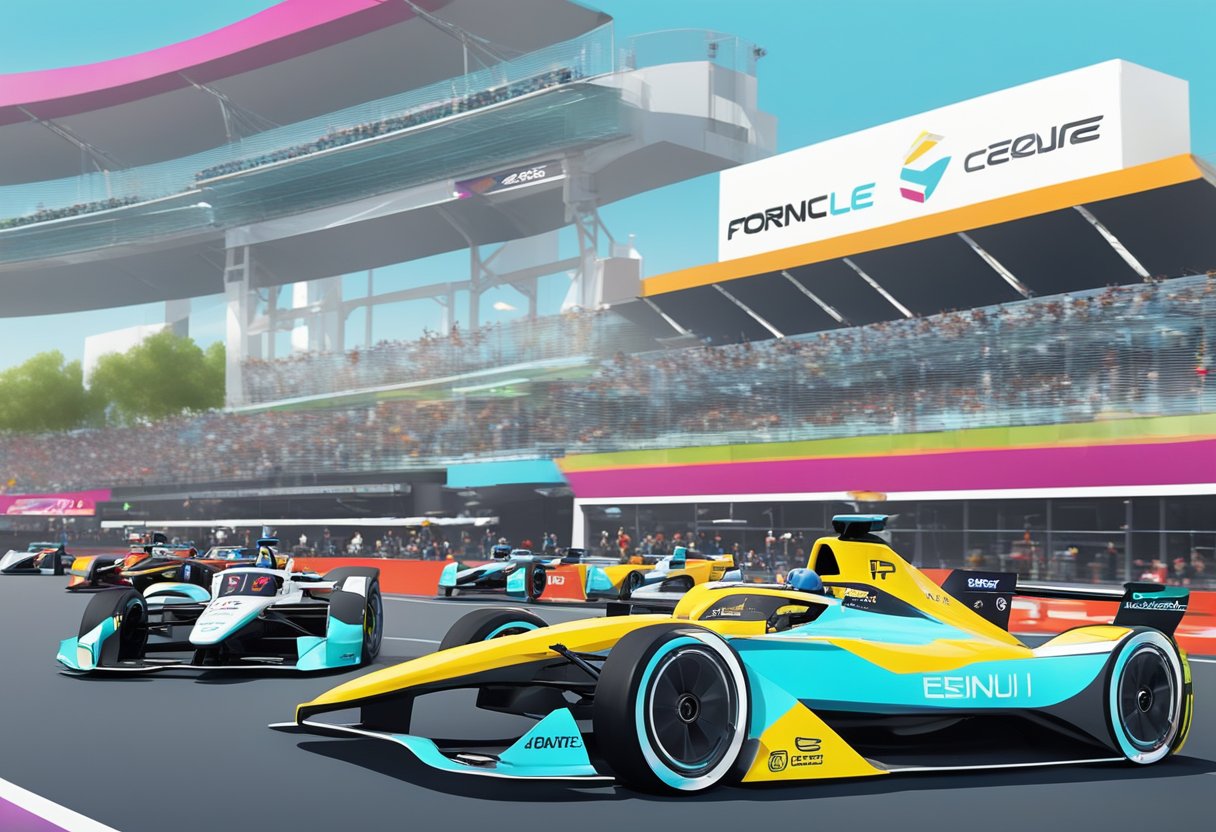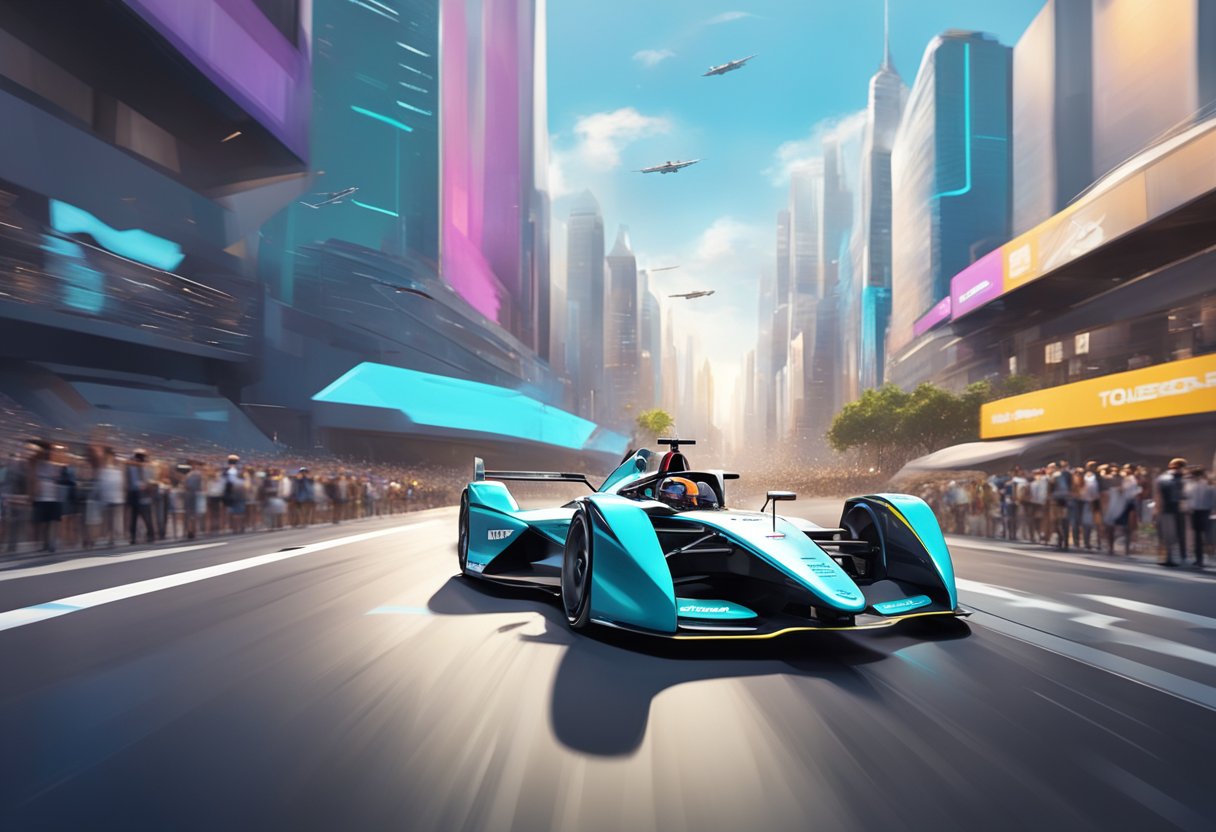Formula E represents the apex of electric vehicle sports, offering a unique mix of innovation, competition, and sustainability. As the premier all-electric racing series, Formula E boasts a global platform where manufacturers and teams collaborate to push the boundaries of electric mobility. The races take place on temporary street circuits, emphasising close racing and strategy, with each event contributing to a season that decides the championship winners.

The series delivers an egalitarian approach to motorsport, with cars sharing the same chassis, battery, and tyres to maintain competitive parity. This emphasis on driver skill and team strategy has garnered Formula E a growing fanbase. With the integration of interactive elements such as ATTACK MODE and FANBOOST, fans are given the power to directly influence the race, further intertwining the spectator experience with the sport.
Key Takeaways
- Formula E is an all-electric racing series that combines high-speed competition with sustainability.
- The series utilises standard chassis and batteries to ensure close and fair racing.
- Interactive fan participation and strategic elements play a significant role in race outcomes.
Overview of Formula E
Formula E is the pinnacle of electric car racing, offering a unique blend of innovation and competition. As a forward-thinking motorsport, it sets the tempo for advancements in electric vehicle technology and sustainable practices within the high-speed racing domain.
History and Evolution
Formula E made its debut in 2014 as the ABB FIA Formula E World Championship. Conceived in 2011, it was established with a mission to revolutionise motorsport and promote electric vehicles. Over the years, it has rapidly evolved, introducing the Gen2 and the latest Gen3 cars.
The Role of Formula E in Motorsport
Formula E has carved out a unique niche as the premier electric car championship. It serves as a testing ground for electric car technology, showcasing sustainable solutions and influencing the development of road cars.
Comparison with Formula 1
While both are pinnacle series in motorsport, Formula E differs significantly from Formula One. An F1 car is more powerful, weighing less and generating over 700kW, while a Formula E car produces 250kW and weighs more. The focus in Formula E is on sustainable racing and technological innovation in electric motors.
Championship Structure
The championship comprises teams and drivers competing over a season for points at various international tracks. The points system is similar to F1, with extra points awarded for pole position and fastest lap, promoting fierce competition among participants.
Technical Regulations
Teams in Formula E use a spec chassis, but they develop their own powertrain – consisting of the electric motor, inverter, and transmission. The battery pack and tyres are standardised, ensuring a level playing field.
Key Innovations
Formula E introduced unique features like Attack Mode and Fanboost, which give temporary power boosts to drivers. These innovations make the racing experience more interactive and engaging.
Economic and Environmental Impact
The series has a strong sustainability ethos, promoting clean energy and emissions reduction. This commitment extends beyond the track, with Formula E influencing positive economic and environmental outcomes in the regions it visits.
Sponsorships and Partnerships
Formula E has attracted an impressive portfolio of sponsors and partnerships, from automotive brands to global companies investing in sustainability. These partnerships help foster technological advancements and shape the series’ progressive image.
Media Coverage and Broadcasting
Formula E has a wide broadcasting reach, with coverage by networks like BBC, Eurosport, and Channel 4. Additionally, live coverage and highlights are also available on digital platforms such as YouTube, making the races accessible to a global audience.
Fan Engagement
Fanboost and interactive digital content on the Formula E YouTube Channel amplify fan engagement. Audience participation, both online and at events, is an integral part of the Formula E experience.
Future Projections
The future of Formula E appears robust with the introduction of the Gen3 car. It is expected to set new benchmarks in performance and sustainability, assuring the ongoing relevance and expansion of the championship.
Seasons and Events
The Formula E Championship is structured around an annual calendar of races, known as E-Prix, which take place on street circuits across notable cities around the globe. Each season presents a series of events where electric single-seater cars compete, emphasising sustainability and innovation.
Annual Calendar
The Formula E calendar spans various months each year, traditionally beginning towards the end of one year and concluding in the summer of the following year. The 2024 season marks the tenth season, featuring races scheduled at intervals to allow teams and drivers to traverse between international locations.
Racing Circuits
Unlike traditional motorsport, Formula E races are predominantly held on temporary street circuits. These circuits bring the excitement of racing to the heart of iconic cities, designed to challenge drivers with tight turns and mixed-speed sections. Each track layout is unique, reflecting the character of its urban setting while adhering to safety standards.
Notable Races
Diriyah: Opening rounds often take place under the lights of Diriyah, offering a spectacular night race setting.
Monaco: The Monaco E-Prix adapts the famed Grand Prix circuit for electric racing, offering a blend of glamour and historical significance.
New York: The New York E-Prix showcases a skyline backdrop, with a circuit in Red Hook, Brooklyn highlighting the championship’s urban appeal.
London: The London E-Prix is distinctive for featuring indoor sections, adding to the innovation of the racing series.
Special Events
Throughout the season, special events and double-header race weekends add excitement. These events can include two races over a single weekend, increasing the challenge for teams and drivers while offering more action for fans. Venues like Mexico City and Berlin have been known to host such events, drawing large crowds and enhancing the race calendar’s appeal.
Teams and Drivers

In the electrifying world of Formula E, each team and driver plays a crucial role in shaping the dynamic of the championship. Ranging from seasoned professionals to emerging talents, the grid is a melting pot of strategy, skill, and innovation.
Current Teams
Formula E is composed of 11 teams, each with a distinctive approach to racing and technology. Notable manufacturers like Nissan, Porsche, BMW, Maserati, and Mercedes-Benz feature prominently, while brands like Jaguar continue to enhance their reputation in electric motorsport. The current rosters are:
- Envision Racing
- NIO 333 FE Team
- DS Techeetah
- Mahindra Racing
- Nissan e.dams
- TAG Heuer Porsche Formula E Team
- Avalanche Andretti Formula E
- BMW i Andretti Motorsport
- ROKiT Venturi Racing
- Mercedes-EQ Formula E Team
- Jaguar TCS Racing
Notable Drivers
Each team fields two drivers, with some garnering attention for their exceptional performances:
- Nick Cassidy (Jaguar TCS Racing) – Notable for a strong showing in Season 9 with four victories.
- Nyck De Vries – His skills contribute to the success of his team, leveraging his experience for tactical advantage.
- Stoffel Vandoorne – Known for his consistent driving and strategic prowess.
- Sam Bird, Edoardo Mortara, and Pascal Wehrlein – Their reputations speak to their capabilities on the street circuits of Formula E.
- Dan Ticktum and Oliver Rowland – Emerging talents taking the grid by storm.
- Jake Dennis – Another promising driver making waves in the series.
Team Strategy and Management
The teams in Formula E not only race for victory but also drive the progression of electric automotive technology. Each team has a highly specialised management framework focused on strategic deployment of power, battery management, and software optimisation. Strategy and foresight are as significant as speed, with teams meticulously planning race execution and adapting to the unique challenges of Formula E circuits. Engaging engineering brilliance and precise management, teams work towards a sustainable and victorious future in motorsport.
Racing Dynamics
Formula E racing showcases a unique blend of strategy and technology in electric motorsport. Race dynamics in Formula E are defined by its distinct qualifying format, points system, race strategies, and the performance of electric vehicles.
Qualifying and Race Format
Formula E utilises a group-based Qualifying Format where drivers compete to set the fastest lap in their respective groups before the top six progress to a Super Pole session to determine the top positions. The race itself lasts for 45 minutes plus one lap, with drivers navigating street circuits that challenge both strategy and car performance.
Points System
Points are awarded based on position, with additional points available for pole position and the fastest lap. In a typical Formula E race, the distribution is as follows:
| Position | Points Awarded |
|---|---|
| 1st | 25 |
| 2nd | 18 |
| 3rd | 15 |
| 4th | 12 |
| 5th | 10 |
| 6th | 8 |
| 7th | 6 |
| 8th | 4 |
| 9th | 2 |
| 10th | 1 |
| Pole Position | 3 |
| Fastest Lap | 1 |
This structure ensures that every position is contested fiercely, contributing to the series’ competitive nature.
Race Strategies
Teams must skilfully manage Race Strategies, which often revolve around energy management and the tactical usage of Attack Mode, a power boost granted when drivers pass through a designated zone off the racing line. Utilising FanBoost, an additional burst of power voted by fans, can also provide a strategic advantage. Strategies adapt to the possibility of a Safety Car period, which can alter energy consumption and race tactics.
Vehicle Performance
The performance of Formula E cars heavily depends on powertrain efficiency and energy management. Cars are designed to reach a maximum Power Output of 250 kW during qualifying and 200 kW during races, with Attack Mode increasing this temporarily to 235 kW. Their acceleration and top speeds are carefully managed to balance speed with the limited energy available during a race.
Cars and Technology
In exploring the realm of Formula E, one must pay attention to the advancements in electric vehicle (EV) technology, particularly in terms of performance, design, and environmental considerations. This includes significant evolutions from Gen2 to Gen3 cars, sophisticated in-car technologies, design innovations, and a focus on sustainable manufacturing practices.
Gen2 vs Gen3 Vehicles
The transition from Gen2 to Gen3 vehicles in Formula E marks a significant shift in electric racing performance. Gen2 cars, known as the workhorses of electric motorsport, have a maximum power output of 250kW and a top speed of approximately 280 km/h. They are equipped with a battery pack capable of lasting an entire race, eliminating the need for mid-race car swaps. In contrast, Gen3 cars are designed to be lighter and more powerful, with an enhanced battery power output of up to 350kW. Significantly, they introduce the capability for fast charging during races, adding a strategic dimension to the competition.
In-Car Technology
The in-car technology of a Formula E vehicle is centred around its core electric components; the electric motor, inverter, and battery pack. Each car’s powertrain is unique to its manufacturer but must conform to Formula E specifications. The power is typically delivered through a rear-mounted electric motor to the wheels via a single differential. The in-car systems are also laced with advanced software to manage energy efficiency, regenerative braking, and power delivery.
Innovation in Car Design
Innovation in Formula E car design is driven by the need for efficiency and performance. The car’s aerodynamics is tailored to reduce drag and enhance energy conservation, while the rear suspension and chassis are engineered to withstand the demands of street circuits that characterise the series. Furthermore, developments in materials and engineering techniques continually push the boundaries of what’s possible in electric race car design.
Sustainability in Car Manufacturing
Sustainability is a cornerstone in the manufacturing of Formula E vehicles. Manufacturers are tasked with not just designing cars that are fast and efficient but also ones that lead the way in sustainable production methods. Use of renewable materials, recyclable components, and a focus on reducing the overall carbon footprint are key aspects. For instance, the battery pack is designed with end-of-life recycling in mind, ensuring that the technology is not just cutting-edge but also environmentally conscious.
Frequently Asked Questions

This section addresses some common inquiries regarding the Formula E Championship, touching on teams, race features, vehicle specs, notable drivers, and the latest Gen 3 evolution.
What are the teams currently competing in Formula E?
As of the most recent season, Formula E consists of 11 teams, each fielding two drivers. These teams are a mix of established motorsport names and manufacturers keen on showcasing their electric vehicle technology.
How does Attack Mode work in Formula E races?
Attack Mode grants drivers a power boost, making races more tactical. To activate it, drivers must go through a designated zone off the racing line, temporarily losing time in exchange for increased power, which can then be used to overtake other drivers.
What are the technical regulations for Formula E vehicles?
Formula E vehicles must adhere to specific regulations, which include a maximum power output of 250kW and a minimum weight of 900kg. These rules ensure competitive balance and promote technological advancements within the confines of the sport.
Who are some of the prominent drivers in Formula E?
The Formula E grid features a mix of experienced drivers and up-and-coming talent. Prominent names include Jean-Éric Vergne, Lucas di Grassi, and Stoffel Vandoorne, all of whom have demonstrated strong performances in past seasons.
Can you explain the concept of Gen 3 in the context of Formula E?
Gen 3 refers to the third generation of Formula E cars set to debut in future seasons. These vehicles represent the pinnacle of electric racing innovation, focusing on improved performance, efficiency, and sustainability.
What distinguishes Formula E from other forms of motor racing?
Formula E is set apart by its exclusive use of electric vehicles, street circuits in city centres, and engagement with fans through interactive elements like Fanboost. It plays a pivotal role in pushing the boundaries of electric vehicle technology and promotes sustainability in motorsports.





